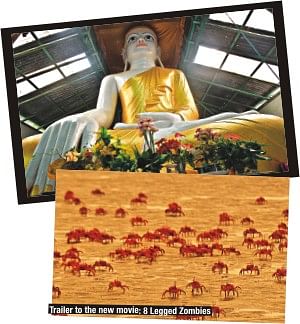Finding Bangladesh Location # 13
The Big Buddha Beach
By Anika Ali & Adnan M. S. Fakir
Photos courtesy of Finding Bangladesh
No, we are not going to talk about Thailand's Big Buddha Beach, but rather one of our own. The south of Bangladesh is sometimes referred to as the Venice of the East; a land weaved with branches of the rivers braiding through, creating a maze of waterways. Our next destination takes us to the final resting place of these river bodies; to the sea, or rather to the daughter of the sea. Kuakata, locally known as sagor konna, is positioned at the Southern tip of our country, approximately 70 km from Patuakhali and 320 km from Dhaka.
Besides the obvious lure of the sea and the bright, red crabs, Kuakata, holds a special attraction for its visitors. About eight kilometers from the beach is the Misri Para Budhha Bihara, home to none other than the largest 27 feet statue of Buddha in Bangladesh. Fancy, huh?
 Getting to Kuakata from Dhaka can be a huge hassle. The journey takes about 12 hours if you go by bus and some parts of the road are quite jumpy. In other words, if you are having tummy troubles, best to delay the trip or get ready for your inner bowel stuff to be thrown out. One has to cross four more ridiculously small ferries (after the big one at Aricha) between Barisal and Kuakata to get to Kuakata, which significantly delays the journey. But once you get there, it's brilliant. Bus fare from Dhaka to Kuakata is roughly Tk.650/person and the best bus probably is Sakura.
Getting to Kuakata from Dhaka can be a huge hassle. The journey takes about 12 hours if you go by bus and some parts of the road are quite jumpy. In other words, if you are having tummy troubles, best to delay the trip or get ready for your inner bowel stuff to be thrown out. One has to cross four more ridiculously small ferries (after the big one at Aricha) between Barisal and Kuakata to get to Kuakata, which significantly delays the journey. But once you get there, it's brilliant. Bus fare from Dhaka to Kuakata is roughly Tk.650/person and the best bus probably is Sakura.
Built with a combination of lime bricks and several other stones, the statue truly is a marvellous and timeless dedication to Budhha. The temple housing this ginormous statue was built by a wealthy Rakhaine by the name of Misri Talukdar.
Unfortunately, we do not know when exactly the statue was built. Our best guess is what the locals say, that is the temple and the statue were constructed roughly 100-150 years ago. Right beside this Budhha Bihara lays one of the earliest wells of Kuakata, dug in 1784 when the Rakhaine people first came here.
But wait, who are these Rakhaine people we speak of?
A long time ago, in 1784, a newly crowned Burmese King by the name of "Bodowpaya" invaded Arakan, the Rakhaine state. The people of Arakan, the Rakhines, fled and came to Golachipa by boat. A large number of them also began to live in the regions that are now Kuakata and Kolapara. To state the obvious, living next to the sea was a difficult feat with a shortage of drinking water. And though the bright, red crabs are delicious to gawk at and to devour, catching them with their speedy legs is a difficult job.
The Rakhines however, were more concerned with the water shortage and they solved this problem by digging numerous wells or kuas in the region. Due to all this digging, the name of the place became "Kuakata," kata being the Bengali word for digging. To be precise, the well dug in 1784 that we mentioned above is exactly the one that gave Kuakata its name.
For more local wonders, histories, legends and mythologies, visit us at www.facebook.com/findingbangladesh

